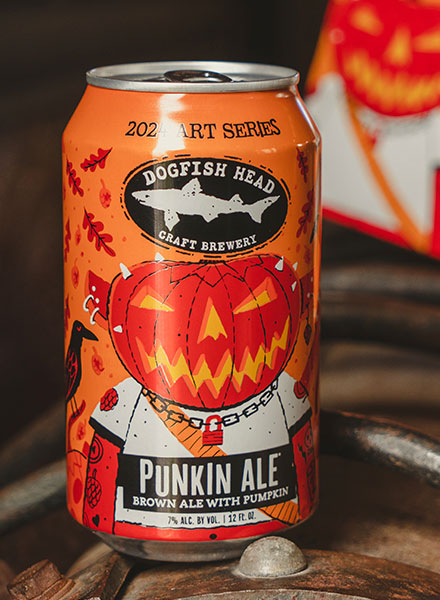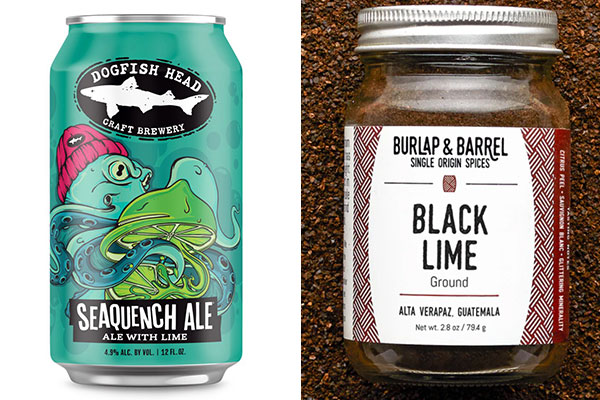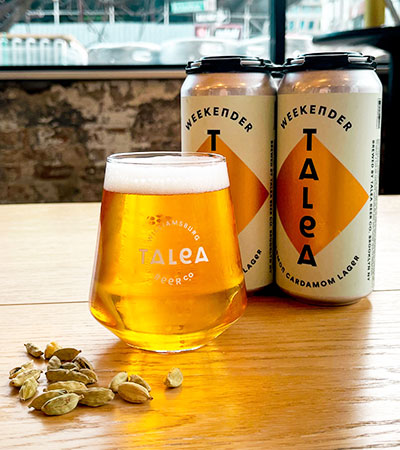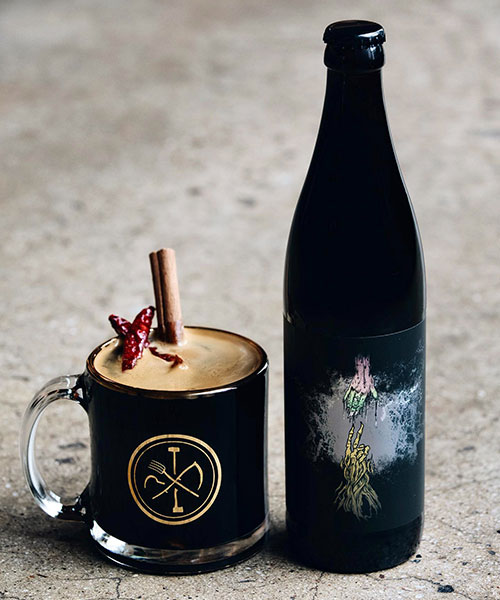A clear sign of spring’s arrival is the parade of Pilsners and crisp Kölsch onto tap lines and store shelves, with their light bitterness that freshens our senses. And close behind come the summery saisons and witbiers highlighted by the citrusy spice of coriander.
By the time we’re ready for indoor drinking again, brewers predictably swing back to fiery cloves and other warming spices by way of pumpkin-spiced ales and Christmas beers. Spices—whether seed, fruit, root, or bark—have long been a staple of celebratory and solstice sips, but thanks to greater access to a broad spectrum of ingredients from around the world, brewers are expanding their pantries, infusing beer with sour sumac and numbing Sichuan peppercorns.
Spiced beers aren’t just waiting for an occasion anymore—they’re now year-round, tapping an ever-changing cupboard of craft brewing.
The OG of Experimentation

Thirty years ago, Sam Calagione co-founded Dogfish Head, Delaware’s first brewpub, bringing ingredients that were once considered “culinary” to the kettle. “Spices, herbs, and exotic fermentable sugars are at the heart of what makes our brand unique,” says Calagione. Six months before Dogfish Head even opened its doors, its fabled Punkin Ale won a recipe contest at Delaware’s own Punkin Chunkin championship, where pumpkins are competitively launched great distances. This catapulted Calagione’s appetite to include more than just pumpkin spice mix in beers.
From there, Dogfish Head’s Namaste White added black peppercorns to its coriander and clove sachet. The Most Comfortable Logger in the Woods, a Vienna-style golden lager brewed with wild blueberries from Maine, was bolstered by ginger, golden turmeric, and herbaceous sage. Goldenmilk Latte, an oat cream ale that emulates haldi doodh, a turmeric-tinged drink from India affectionately known as golden milk, tinkers with turmeric, ginger, cardamom, cinnamon, and smoked star anise for a spice-forward finish.
But spices aren’t to be used haphazardly. Mark Safarik, Dogfish Head’s brewmaster, warns that with spices like cardamon that can be quite powerful, a little goes a long way.
“[Too much of a spice] can step all over everything, become one note, and not integrate with other flavors,” says Safarik, adding that it really depends on how much is used when and where.
When spices are introduced on the hot side, the brewing process prior to fermentation, the volatilization of flavor and aroma compounds of the spices causes chemical changes, according to Bryan Selders, Dogfish Head’s brewing manager and head of taprooms. “The cold side [fermentation, conditioning, and packaging] is a more pure expression of raw spice, like fresh cracked pepper on eggs in the morning, rather than seasoning soup while it simmers.”
Thinking Outside the Box

When Dogfish Head premiered its celebrated SeaQuench Ale in 2016—a combination of Kolsch, gose, and Berliner weisse elements—it was the unique combination of black lime and sea salt that stood out most to customers. The beer’s release coincided with the emergence of Burlap & Barrel, a single-origin spice company; it soon began supplying Dogfish Head with whole black limes. [Full transparency: I do some work for Burlap & Barrel.] Sourced from Guatemala, the black limes are cured and sun-dried.
“Typically, [black lime is used] whole in Persian stews,” says Ethan Frisch, Burlap’s co-founder, who notes that they sell their product ground. Dogfish Head wanted to work with whole black limes, so Frisch made a special allowance as Dogfish designed a machine called Busta Limes, meant to crush them into the exact texture they wanted for infusing, without any grainy particulates needing to be strained out of the beer.
“One of the challenges in adapting culinary spices for brewing is that flavors can act differently than when cooking,” reinforces Frisch, whose father was an award-winning homebrewer. He began making beer himself when working for non-governmental organizations in Afghanistan, saving used champagne bottles from fancy embassy parties to reuse later.
“Most commonly you see spices in darker beers,” Frisch observes. “I think the robustness of those flavors—roasty, malty—stands up nicely to spices, but I’ve seen them in sour beers [as well],” pointing to the traditional use of coriander in gose, but also iterations with cumin as well. Burlap & Barrel’s Wild Mountain Cumin was the first spice Frisch started importing.

Time for Tinkering
Sometimes brewers use spices to align the beer to the food it’s served with. At TALEA Beer Co. in Brooklyn, head brewer Eric Brown uses herbs and spices such as dried mint and mustard in a mango sour that tastes like mango pickle, as in the case of a lager he made last summer for a clam shack pop-up. The beer was made with lime and Old Bay seasoning. They rimmed the glasses with purple dulse, a seaweed.
In the summer, when sours are in high demand, TALEA offers a blueberry pomegranate fruited gose; Brown pulls a small batch and infuses some with sumac. “Citric acid comes from the fruit, but then there’s the malic acid in sumac that has a mouth-coating effect that you don’t get in most sours.” Their Weekender Lager series, displaying a duo of fruit and spice such as lemon cardamom, tangerine anise, and lime salt, are steeped similar to tea using muslin bags. Brown has also been tinkering with a universal brew tank, used for dry hopping, for faster flavor infusions. “It’s a recirculating tank with a filter column,” says Brown. “It’s on casters as well, so we can set it next to whatever tank we’re attempting to dose.”
Spices find life even after being added as adjuncts to a tank. Burial Beer Co. in Asheville, North Carolina barrels and bottle conditions its higher ABVs offerings—they brew about 45 imperial stouts each year. The Cursed Path of The Forever Unstill is an imperial stout coalesced with coffee beans, enriched with vanilla beans, and rounded out by cinnamon.

“Over the years we’ve used vanilla from almost every continent and find ourselves partial to the marshmallowy Tahitian and Coca Cola Mexican varieties,” says Doug Reiser, Burial’s cofounder. Regarding cinnamon, Reiser believes it “has a bad reputation of being hot and having one linear note,” but he finally found the right one from Vietnam. He says he’s able to use it in any type of beer, from IPAs to sours and of course, in stouts.
With that same kind of slight spiciness of cinnamon in mind, Resier went on to brew Walk Off Into The Unequivocable, another imperial stout that gets all roasty and toasty with cocoa nibs, is sweet and creamy from vanilla beans, but has a bite of Black Urfa Chili and ginger on the finish.
“Dried aged chiles have long been used to balance sweetness, akin to a mole sauce,” he explained. While the chile has heat, urfa also imparts a unique raisin/pineapple flavor profile. “The chile also balances acidity so nicely and could be the basis of a beautiful barleywine,” suggests Reiser.
The Sky’s the Limit
While single spices are certainly a focus, Lamplighter Brewing in Cambridge, Massachusetts, collaborates with nearby Curio Spice Co. to source spice blends for its beer. In 2023, its Belgian-style witbier called Deja Vu had the requisite coriander seeds and dried orange peel, but was fortified by French lavender and pink pepper berries.
In 2024, David S. Pumpkins, a nod to a Tom Hanks Saturday Night Live character, showcased fenugreek alongside the familiar allspice and cinnamon in a pumpkin spice mix. Rise Up, a wheat ale tinged crimson with hibiscus flowers, was seasoned with a spice blend called Fleur Spice (cardamon, pink pepper berries, hibiscus, rose petals, lavender, coriander, spearmint, and ylang ylang).
In the same spirit, Steve Parker, head brewer at Fidens Brewing in Albany, New York, has only just begun playing with spice—sumac and Wild Timur peppers, which are akin to Sichuan peppercorns, end up in red ale named Internal Energy. “I was very surprised about the amount of citrusy grapefruit flavor that carried over in the whirlpool, but the tingle doesn’t carry over,” he said. Parker hopped the beer with a little Chinook too, which plays well with red ales but also complements the citrus and pine of the pepper.
“I’m really just dipping my toes into the spice world,” Parker admits, leaning toward his larder for new inspiration, reaching past the proverbial salt and pepper for seasoning.
The post It’s Always Spiced Beer Season appeared first on CraftBeer.com.
